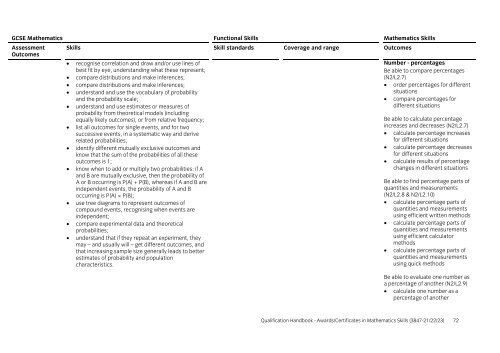Awards/certificates in mathematics skills (3847-21/22 ... - City & Guilds
Awards/certificates in mathematics skills (3847-21/22 ... - City & Guilds
Awards/certificates in mathematics skills (3847-21/22 ... - City & Guilds
Create successful ePaper yourself
Turn your PDF publications into a flip-book with our unique Google optimized e-Paper software.
GCSE Mathematics Functional Skills Mathematics Skills<br />
Assessment Skills Skill standards Coverage and range Outcomes<br />
Outcomes<br />
• recognise correlation and draw and/or use l<strong>in</strong>es of<br />
best fit by eye, understand<strong>in</strong>g what these represent;<br />
• compare distributions and make <strong>in</strong>ferences;<br />
• compare distributions and make <strong>in</strong>ferences;<br />
• understand and use the vocabulary of probability<br />
and the probability scale;<br />
• understand and use estimates or measures of<br />
probability from theoretical models (<strong>in</strong>clud<strong>in</strong>g<br />
equally likely outcomes), or from relative frequency;<br />
• list all outcomes for s<strong>in</strong>gle events, and for two<br />
successive events, <strong>in</strong> a systematic way and derive<br />
related probabilities;<br />
• identify different mutually exclusive outcomes and<br />
know that the sum of the probabilities of all these<br />
outcomes is 1;<br />
• know when to add or multiply two probabilities: if A<br />
and B are mutually exclusive, then the probability of<br />
A or B occurr<strong>in</strong>g is P(A) + P(B), whereas if A and B are<br />
<strong>in</strong>dependent events, the probability of A and B<br />
occurr<strong>in</strong>g is P(A) × P(B);<br />
• use tree diagrams to represent outcomes of<br />
compound events, recognis<strong>in</strong>g when events are<br />
<strong>in</strong>dependent;<br />
• compare experimental data and theoretical<br />
probabilities;<br />
• understand that if they repeat an experiment, they<br />
may – and usually will – get different outcomes, and<br />
that <strong>in</strong>creas<strong>in</strong>g sample size generally leads to better<br />
estimates of probability and population<br />
characteristics.<br />
Number - percentages<br />
Be able to compare percentages<br />
(N2/L2.7)<br />
• order percentages for different<br />
situations<br />
• compare percentages for<br />
different situations<br />
Be able to calculate percentage<br />
<strong>in</strong>creases and decreases (N2/L2.7)<br />
• calculate percentage <strong>in</strong>creases<br />
for different situations<br />
• calculate percentage decreases<br />
for different situations<br />
• calculate results of percentage<br />
changes <strong>in</strong> different situations<br />
Be able to f<strong>in</strong>d percentage parts of<br />
quantities and measurements<br />
(N2/L2.8 & N2/L2.10)<br />
• calculate percentage parts of<br />
quantities and measurements<br />
us<strong>in</strong>g efficient written methods<br />
• calculate percentage parts of<br />
quantities and measurements<br />
us<strong>in</strong>g efficient calculator<br />
methods<br />
• calculate percentage parts of<br />
quantities and measurements<br />
us<strong>in</strong>g quick methods<br />
Be able to evaluate one number as<br />
a percentage of another (N2/L2.9)<br />
• calculate one number as a<br />
percentage of another<br />
Qualification Handbook - <strong>Awards</strong>/Certificates <strong>in</strong> Mathematics Skills (<strong>3847</strong>-<strong>21</strong>/<strong>22</strong>/23) 72
















